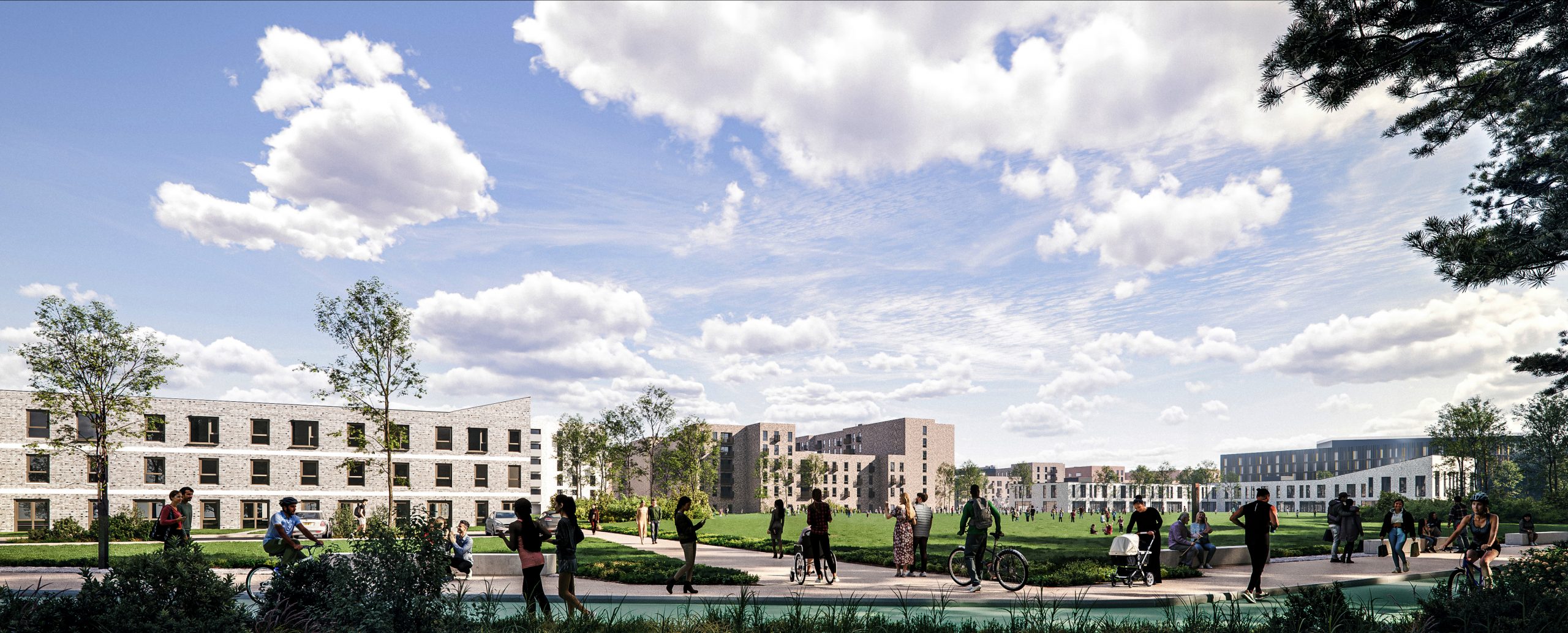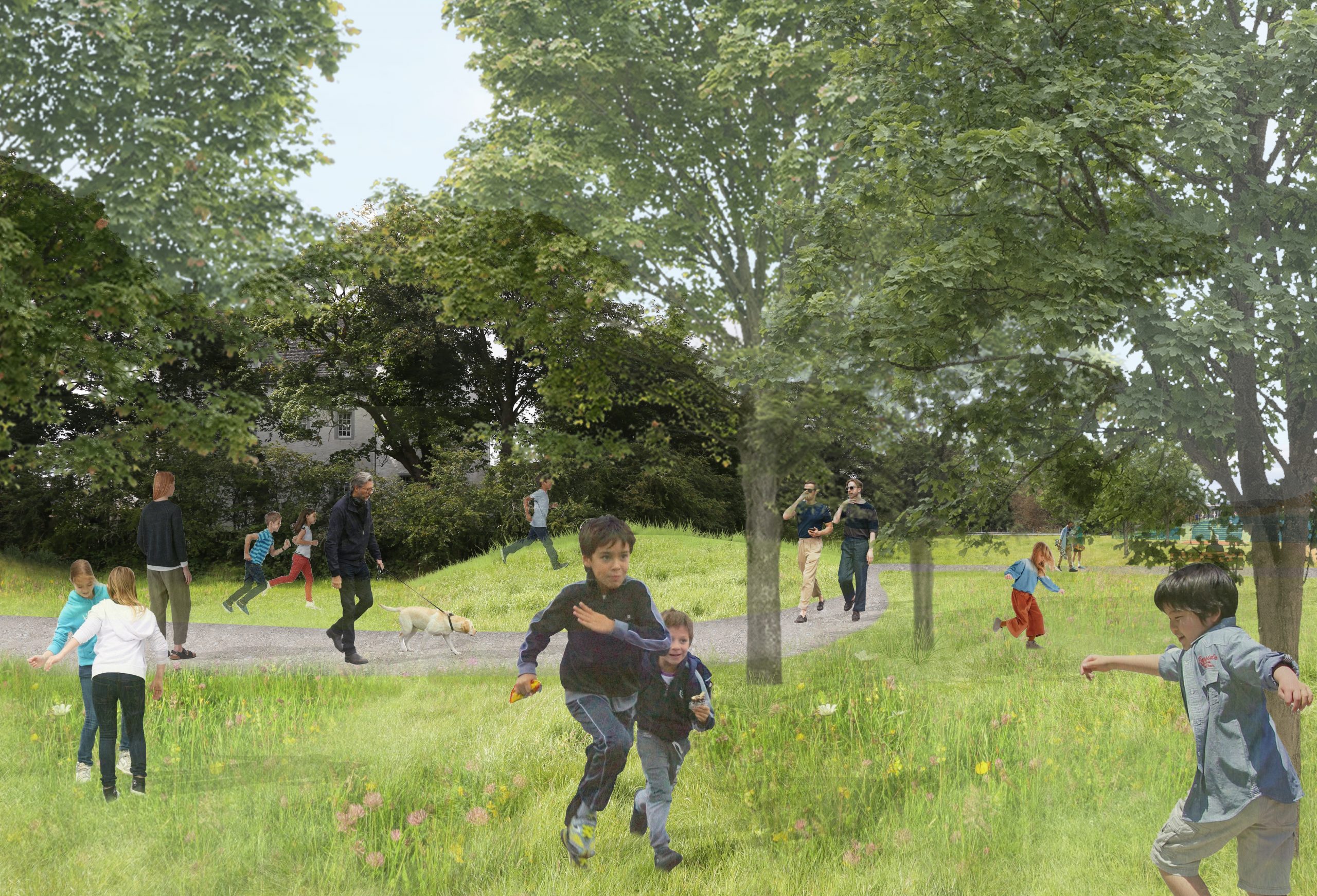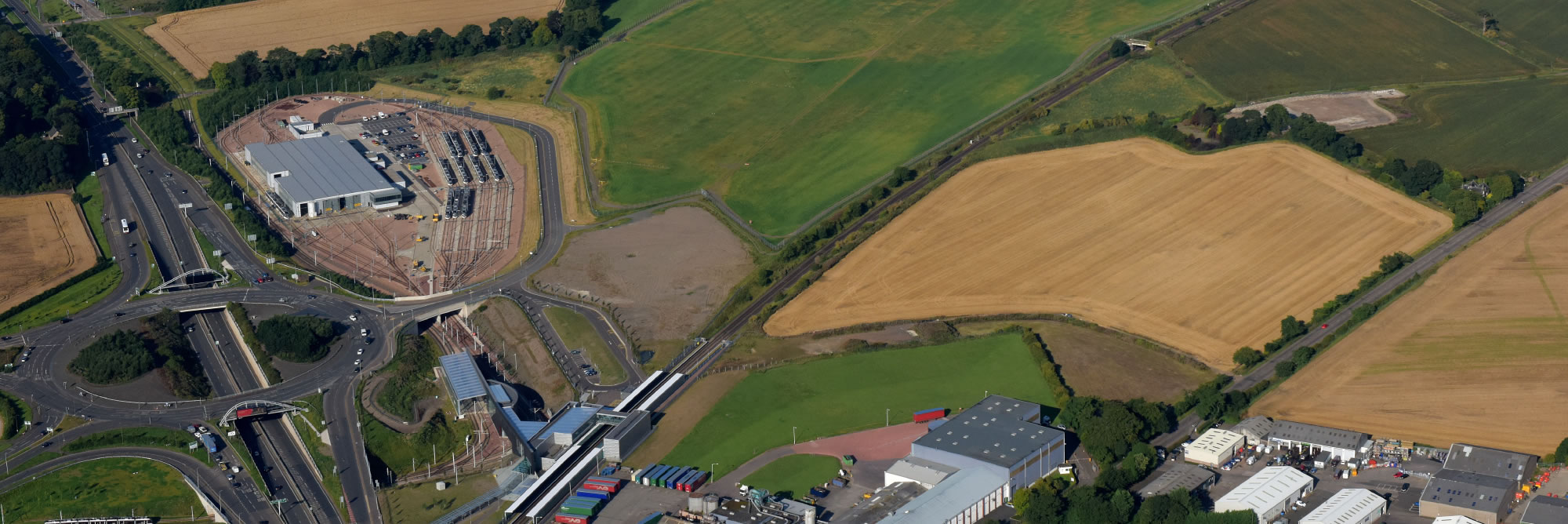In its simplest form biodiversity is about the variety of life on earth, the more biodiversity we have the more secure life on earth is, the more stable our access to water, food, and medicines, the more opportunity we have to offset carbon and reduce climate change.
It seems obvious that to preserve our own lives we need to protect and enhance biodiversity, but in fact, over the last 50 years, we’ve destroyed over 68% of the world’s animal populations.
Now we need to take positive action to rebound from this pending disaster, avoid future losses and start to regenerate and recover from this biodiversity crisis.
That’s why we want Elements Edinburgh to make a positive difference, it’ll complement its natural surroundings, be in harmony with nature and promote wellbeing through the appreciation of the Gogar Burn and the biodiversity of the surrounding area.
Not only are we committed to preserving the existing diversity on site, but we also aim to enhance this by having an overall positive impact on the biodiversity of the area.
We’ll implement several biodiversity enhancements focussing on habitats along Gogar Burn. Landscape planting will provide improved opportunities for invertebrates, the provision of bat boxes will encourage roosting bats in the trees, and we’ll work with environmental bodies to identify the potential to improve fish life in the burn itself.
This will give our residents and occupiers unrivalled access to experience the natural environment that surrounds them, and support them in understanding the role they can play to sustain and grow biodiversity further for future generations.
In addition to the Gogar Burn we’ll also incorporate a rain garden corridor and residential ‘green fingers’ between homes meaning the total green space will be equivalent to more than 50% of the site’s overall area meaning the blue-green connectivity will support not only Elements Edinburgh but the whole of west Edinburgh.
After being commissioned by Scottish Government, in 2020 Mark Logan published a review of the Scottish Technology Ecosystem “the Review”. His report identified that the Scottish eco-system is at pre-tipping point, where critical mass has not quite been achieved and therefore you do not get the benefit of “several virtuous network effects which start to spontaneously operate to continually strengthen the ecosystem without further intervention required.”
The Review identified three fundamental supporting areas which a successful technology ecosystem depends on:
- Education and Talent
- Infrastructure
- Funding
It is the second point identified that is of particular interest to Elements Edinburgh. The Review goes on to explain that Infrastructure “includes physical co-location environments for start-ups and the social infrastructure required to support a vibrant technology ecosystem.”
An ecosystem is an environment where tech related ideas evolve into start up organisations which then develop and integrate into larger organisations.
At Elements Edinburgh our ambition is to build a place that will be Scotland’s digital heart. It has been forecast by Scottish Futures Trust that 175,000 new digital jobs will be created in Scotland by 2030, of which 52,500 will be in the Edinburgh region. At Elements Edinburgh there will be 1 million sq.ft of commercial space designed to provide an environment to develop start-ups, grow established digital organisations and integrate them with digital education centres. Elements Edinburgh will support a flourishing digital ecosystem with 6,000+ jobs delivering £450M+ GVA (Gross Value Add) to the Scottish economy (Biggar Economics – see below).
This place for these tech companies will be integrated with an intergenerational community who live at Elements Edinburgh and who will share local community amenities and green parkland, allowing every generation to become curious and able to engage with this digital ecosystem.
Elements Edinburgh’s location allows international organisations to establish a UK regional office next to a well-connected international travel hub as well as offering employees all the benefits of living in a city like Edinburgh. With Edinburgh Gateway Station on its doorstep the location provides easy access to train and tram links.
At Elements Edinburgh we invited Biggar Economics “Biggar” to undertake an independent economic analysis of the masterplan, with a key focus on our aspirations to develop a digital ecosystem for organisations at various stages of the growth life cycle. Biggar highlighted that the digital sector is one of the growth sectors of the Scottish economy and it drives a GVA per employee that is 73% higher than the Scottish economy average. Edinburgh already has in place established infrastructure in the digital arena, and by creating a new place for organisations to come together in spaces that will foster collaboration and knowledge exchange, this will foster further productivity growth. The development would integrate the existing digital economy landscape and offer new opportunities, in particular the extension westward of the “digital corridor” between University of Edinburgh in the city and Fountainbridge, linking this corridor to an international travel hub at Edinburgh Airport. Elements Edinburgh would also offer an additional space for expanding businesses and international investors looking to invest in Scotland’s digital talent.
While we can’t predict with any real certainty what our offices will look like in the future, we can be fairly certain that they will need to be different, with flexibility to provide a variety of spaces rather than formulaic groups of identical workstations. Above all however they will need to be energy efficient and sustainable as we move towards net zero.
Working from home, flexible and hybrid working, together with Zoom and Teams have changed ‘work’ for good, but they can leave us feeling isolated, without the face-to-face connections and interaction that stimulate and drive us all. Office environments need to provide experiences that working from home can’t.
With more of us returning to our workplaces, on either a full time or flexible basis, there will inevitably be demand for environments that foster interaction, with a variety of spaces for collaboration, 1:1’s, break-outs, team sessions, meeting pods and hot desking, whether standing up or sitting down. Few existing offices have been designed with the flexibility to provide ‘agile workspaces’ and some will rapidly become obsolete.
As we move forward and realise that opportunities for better work/life balances and wellbeing can be embraced, office design will focus more shared spaces that encourage people to come together, interact socially and share ideas in less formal settings. There is also heightened awareness of the benefits that the fresh air and natural surroundings of shared, safe green spaces can bring to our wellbeing whilst improving biodiversity.
Unfortunately, many existing office buildings are inefficient with high energy costs, which are only going to increase further. In an ideal world the most sustainable solution would obviously be to re-use and adapt existing commercial buildings, but retrofitting is often expensive and compromised.
Energy Performance Certificates are a measure of energy consumption and, when combined with different standards (such as BREEAM, Fitwell and NABERS), can drive improved energy performance. Changes to regulation in England and Wales will mean that all leased commercial buildings will need an EPC rating of ‘E’ or better by next year, rising to ‘C’ by 2027 and ‘B’ by 2030. In Scotland a new regulatory framework is being developed to ensure all non-domestic buildings are net zero for heating by 2045, with initial consultation this year leading to regulation by 2025.
The zero-carbon journey needs to account for both embedded emissions (i.e. those incurred during manufacture, transport to site and installation) together with operational emissions during the building’s lifecycle. Theoretical modelling needs to be verified in real life, once buildings are occupied and if a universal standard or methodology could be agreed it would help reduce the number of misleading environmental claims.
One of the consequences of the increased requirement to reduce energy consumption will be a demand for greener buildings, with boards and investors increasingly focussed on sustainability and wider ESG issues. New office buildings may be only part of the answer but their journey to net zero should embrace the concerns and desires of employers and employees alike, with access to open space and future flexibility built in. Not only is wellbeing a valuable currency in recruitment and retention, shared open spaces can enliven our neighbourhoods and communities to everyone’s benefit.
At Elements Edinburgh Crosswind Developments is committed to providing a genuine mixed-use community on a brownfield site, with the most energy efficient commercial and residential space. It will deliver a well-connected and unique live/work environment blending the benefits of both urban living and generous open, safe green spaces on the edge of town. Through careful placemaking the buildings and the spaces around them will stimulate socialising, encourage relaxation and complement the key facilities and amenities that underpin a true 20-minute neighbourhood.
Undertaking any new-build is a huge responsibility but when we do build, it must be with a genuine commitment not only to sustainability for future generations, but to making a positive contribution to how people can live and work locally.
Towns and cities have always been places for people to meet and interact, with workers arriving in the morning and leaving at the end of the day like the flow and ebb of the tide.
This rhythm produces the vitality that defines so many great cities, making them stimulating and compelling environments for business, pleasure and general wellbeing.
But in the wake of Covid, isn’t it about time that the public realm was designed with people at its heart creating spaces with a scale and interest that we naturally respond to?
Cities are used primarily by people, not vehicles or buildings, yet how people want to behave and interact isn’t really prioritised. The grandeur of the public spaces, the width of the boulevards, the ‘statement architecture’ all seem to come first.
Look at the thousands of pages of regulations, standards and guidance devoted to the quest for free, safe and unimpeded movement of vehicles in places that should actually be designed fundamentally for walking or cycling.
Before motorised transport, streets and public spaces were based on pedestrian movement and their scale reflected this whether designed for market trade, religion or local government. More recently within 5 miles of the centre of London average vehicle speed fell by 2.48 mph to just 7.1 mph between 2016 and 2019. (In-car Cleverness study and London.gov/questions)
Imagine an entire town or city centre where pedestrians and cyclists have unchallenged priority; where it is vehicles that are marginalised and obliged to give way. How liberating would that be? And how much livelier and more interesting would the spaces become with a human scale that people can relate to?
Vast open public spaces limit physical interaction, putting people too far apart to engage with each other spontaneously. The sense of human scale is lost with a uniformity of experience which palls quickly. Any urban environment should work at walking pace and at human eye-level, rather than through a car window.
Since our days as cave-dwellers humans have gravitated towards the edges of space for safety and this instinct is still evident today. You just need to watch how people move in the large public city squares or the piazzas of Italian towns. Simply reducing vehicles is only a partial answer.
Whilst suburbia can be inane and sterile lacking the atmosphere or people to generate the vitality of denser mixed-use urban areas, cities need open spaces for recreation and to breathe. Shared, overlooked open spaces can be adopted by residents, providing opportunities for locally grown food, increased biodiversity and addressing climate change through sustainable drainage initiatives. Community orchards, allotments, play areas, wildflower meadows and wetlands all provide opportunities for improved well-being while bringing people together.
Unsurprisingly research has shown that people who live within 10 minutes’ walk of a local urban green space are twice as likely to achieve the recommended levels of healthy walking (2.5 hours) per week as those who did not and are more than twice as likely to be satisfied with life. (www.idgo.ac.uk)
A positive way of tackling CO2 emissions is to reduce the need for private vehicle travel, especially single-occupancy cars. The much talked about 20-minute neighbourhood, with most of what you need to live and work within easy walking distance, frees people up to walk and cycle locally, meet people and get to know the local retailers and neighbours in their community.
The environmental impact of cars and the resulting taxation will make private car ownership increasingly unattractive in the future. Public transport, active travel, car clubs and car sharing will steadily replace many private cars, but having evolved with cars at their heart, the cities we’ll be left with will need to be reclaimed sympathetically for pedestrians and cyclists.
Copenhagen, Melbourne and Vienna are leading the way in terms of this reclamation and they frequently top the lists of ‘most liveable cities in the world’, delivering liveability, sustainability and better health for their residents. They have demonstrated that removing cars doesn’t reduce retail footfall, instead shopping becomes a more varied and richer experience.
As the pioneer in people-centred urban design Jan Gehl says:
“If you make streets better for cars you get more traffic. If you make more bicycle infrastructure you get more bicycles. If you invite people to walk more and use public spaces more, you get more life in the city. You get what you invite.”
New digital quarter would support £438m of GVA every year
Elements Edinburgh unveiled as name for first phase as public consultation begins
A dedicated Digital Quarter, aimed at attracting high value technology jobs, could provide a significant boost to Scotland’s economic growth, according to a new report
New analysis on the potential economic impact of a proposal to develop a strategically important site in the west of Edinburgh calculates that over 6000 jobs could be created by the development supporting £438m of Gross Valued Added (GVA) in Scotland. GVA is a measure of economic output.
The new figure comes as the company behind the 65-acre brownfield site near Edinburgh Airport unveils new branding for the first stage of the project.
Elements Edinburgh will be the home for an innovative, sustainable and inclusive residential, commercial and retail development in West Edinburgh. As well as the Digital Quarter as part of 700,000 sq. ft of office space, the development will include 2400 homes – 25% of which will be affordable housing – retail units and hotels.
The site is one of the best connected in Scotland with immediate access to air, road and rail networks. Elements Edinburgh will also aim for the highest standards when it comes to sustainable energy, active transport and green spaces. Plans include developing a new informal park on site around the Gogar Burn.
The Digital Quarter plans were unveiled earlier this year by Crosswind Developments, the company behind the project. The aim is to attract global technology companies while providing facilities to allow home grown tech start-ups to collaborate and thrive.
New analysis by BiGGAR Economics looked at the potential benefit to Scotland in attracting technology
jobs while giving home grown companies’ greater opportunities for collaboration.
It found that every year, the Digital Quarter could support £438 million in Gross Value Added (GVA), which is a measure of economic output, and 6400 jobs in Edinburgh.
The digital sector is one of the growth sectors of the Scottish economy and has a GVA per employee of £78,480 – 73% higher than the Scottish average – which the report says would generate an additional £160m per year (as part of the £438m) compared to a similar development with non-digital jobs.
The development would also create around a significant number of jobs during the construction phase.
The report by BiGGAR Economics says: “The Digital Quarter would provide Edinburgh with a hub for growing businesses, an ideal base for international investors and would complement existing spaces for start-ups and for knowledge-exchange between business and academia.
“The improvement in the spatial organisation of the Edinburgh digital sector with the provision of spaces supporting businesses from their birth, through their expansion and to their internationalisation, alongside the possibility of knowledge transfer from co-working opportunities, is likely to have an impact on the productivity of the companies located in the Digital Quarter.”
Edinburgh is already home to the largest cluster of technology companies in Scotland and employs around 24% of those working in the Scottish digital sector.
The expansion of the Scottish digital sector could also provide opportunities for private-sector led efforts at closing the ‘digital divide’, through, for instance, the provision of digital education programmes targeted at low-income and low-digital access households.
The report also says that by expanding the provision of facilities for digital companies and boosting Edinburgh’s stand as a digital city could also provide a positive impact on non-digital sectors that play an important role in the city economy, including financial services and life sciences.
John Watson, chief executive of Crosswind welcomed the report’s findings.
“This confirms our belief that a dedicated Digital Quarter within Elements Edinburgh would be a significant boost to not just the city but the whole Scottish economy.
“And many of the companies that would benefit are ones that are already well established but are becoming increasingly digital focused such as financial services.
“We are also determined that Elements Edinburgh will be an innovative, sustainable and inclusive development with the environment at its heart.”
Consultation with relevant stakeholders, including the local community, began earlier this year.
A wider public consultation begins next month with an exhibition of plans for the site at the Gyle Shopping Centre on January 14 and 15. A Proposal of Application Notice (PAN) was submitted to the City of Edinburgh Council in October and full application is expected to be submitted in the Spring of 2020.
A plan to bring thousands of jobs to Edinburgh and attract global technology companies while helping develop home-grown digital businesses has been unveiled.
A dedicated ‘Digital Quarter’ will be the centre point of the 150-acre Crosswind site development near Edinburgh Airport.
The development of this strategically important, brownfield site will open up derelict land, build affordable housing, develop commercial properties and create local amenities.
Working with other agencies, the company behind the plan, Crosswind Developments, aims to create a unique Scottish ‘digital community’ which would augment Edinburgh’s existing qualities as an attractive location for global companies.
The Digital Quarter would provide the kind of transport connections, offices, housing and leisure facilities that global technology companies expect when choosing where to locate, allowing Edinburgh to better compete with key existing European destinations.
The Crosswind site is within easy reach of much of Scotland’s main population centres and is located next door to Edinburgh Airport which has more UK and international connections than any other Scottish airport.
John Watson, chief executive of Crosswind Developments, said the site offered a unique opportunity.
“Scotland, and Edinburgh in particular, should be an ideal location for global technology jobs but without a dedicated approach to creating the kind of environment technology companies are looking for, it’s much harder to bring that investment here,” he said.
“These companies want modern, state of the art offices, world class connectivity, an environment that is attractive to its workforce with easy access to global connections. A pool of high quality graduates is another important factor.
“Crosswind is, perhaps, one of the best connected, undeveloped sites in Scotland with immediate access to air, rail and road transport. It will have a focus on the kind of housing, working space and leisure facilities that people demand.
“Working with others, we believe we can make this part of Edinburgh one of the most attractive locations in the world for these companies while also nurturing home grown start-ups.”
While many global technology firms are located in large cities, smaller centres are becoming popular as a smaller footprint allows shorter commutes, easier access to amenities and a better work/life balance. Cities like Amsterdam, Dublin and Berlin have all been successful in attracting the kind of firms the Digital Quarter could house.
“We will be working closely with all our partners, and the local communities, to ensure that our plans meet all their needs,” said Mr Watson.
“This is a fantastic opportunity not just for Edinburgh but the whole of Scotland. Our relationship with Edinburgh Airport will help us develop strong UK and international connections and gives the site a unique advantage.”
Mr Watson has joined other developers and delegations from the City of Edinburgh Council and the Scottish Government at MIPIM, the world’s largest event for property developers and investors, which is taking place in Cannes this week.
Crosswind, which was set up by infrastructure investment giant Global Infrastructure Partners which also owns Edinburgh Airport, operates as an independent company with its own board of directors and is now moving into the consultation and planning phase of the project.
Alistair Darling, the former Chancellor of the Exchequer and an Edinburgh MP for 28 years, chairs the Crosswind board which includes Lesley Sawers, the Equality and Human Rights Commissioner for Scotland who has over 30 years experience at a senior level within both the public and private sectors, Andrew Sutherland, the Joint Managing Director of Miller Developments who brings extensive experience of the commercial property and housing sectors, investment specialist Andrew Gillespie-Smith and Mr Watson.
The development is expected to generate a significant capital investment in Edinburgh and Scotland’s economy. The project aims to fit its ambitions with the Scottish Government and the City of Edinburgh Council’s economic strategies and would strengthen the economic resilience of the local communities surrounding the site.
Crosswind has been working with a number of partners on the plans including Lichfields Planning Consultants, engineering and development consultants Mott MacDonald, Corstorphine + Wright architects, commercial estate agents Cushman & Wakefield, legal advisers Shepherd & Wedderburn and design agency Project.
Notes to Editors;
Crosswind is a 150 acre site in and around the defunct Runway 12/30 at Edinburgh Airport. The runway has been decommissioned and is not in use.
MIPIM is Marché International des Professionnels d’Immobilier. It is hosted by Reed MIDEM and includes an exhibition area, networking events and conference sessions over a period of 4 days.
There were 90,000 technology roles in Scotland in 2017. The Scottish Government wants to target 150,000 digital jobs in Scotland by 2021
Edinburgh was recently named the UK’s top city for start-ups and attracts more foreign investment than any other tech cluster in the UK, outside London. According to Tech Nation Edinburgh has 92% growth potential.
Edinburgh hosts the largest number of tech firms in Scotland (25%)
Technology firms contributed £5bn to the Scottish economy in 2016 and GVA is forecast to grow by 38% by 2024.

Why is biodiversity so important?
17th November 2022
In its simplest form biodiversity is about the variety of life on earth, the more biodiversity we have the more secure life on earth is, the more stable our access…

The technology sector is forecast to be one of Scotland’s fastest growing sectors.
17th November 2022
After being commissioned by Scottish Government, in 2020 Mark Logan published a review of the Scottish Technology Ecosystem “the Review”. His report identified that the Scottish eco-system is at pre-tipping…

The Future of Offices
16th November 2022
While we can’t predict with any real certainty what our offices will look like in the future, we can be fairly certain that they will need to be different, with…

It’s time we gave our towns and cities back to people
16th November 2022
Towns and cities have always been places for people to meet and interact, with workers arriving in the morning and leaving at the end of the day like the flow…

6400 jobs created by development of strategic site next to Edinburgh Airport
17th December 2019
New digital quarter would support £438m of GVA every year Elements Edinburgh unveiled as name for first phase as public consultation begins A dedicated Digital Quarter, aimed at attracting high…

Strategic development of Edinburgh site to attract jobs and investment
12th March 2019
A plan to bring thousands of jobs to Edinburgh and attract global technology companies while helping develop home-grown digital businesses has been unveiled. A dedicated ‘Digital Quarter’ will be the…


